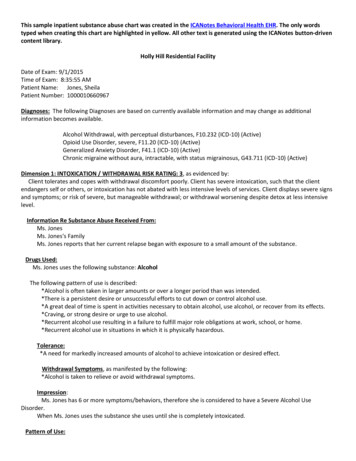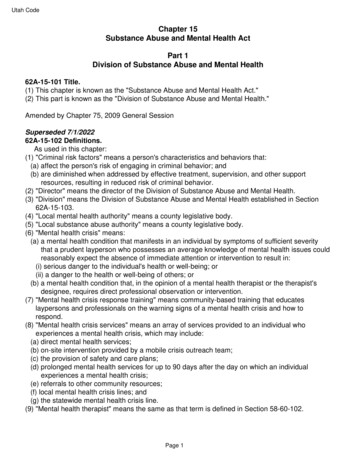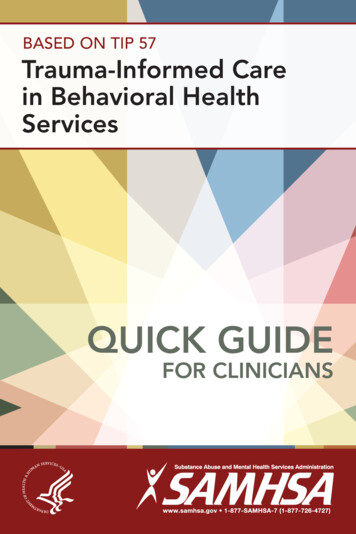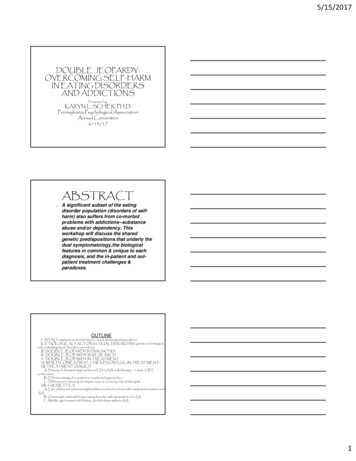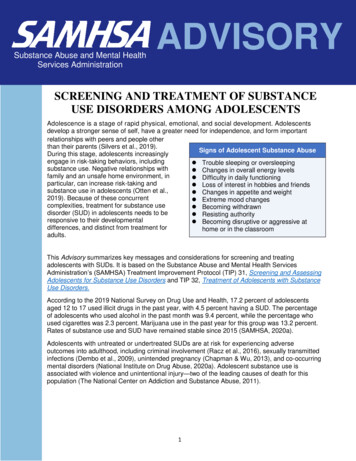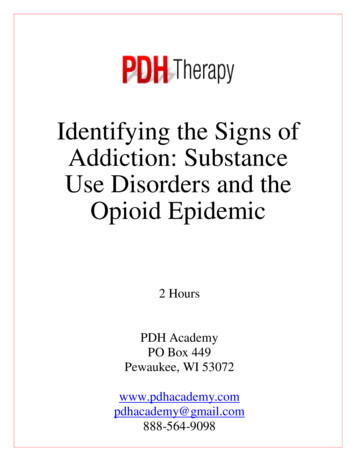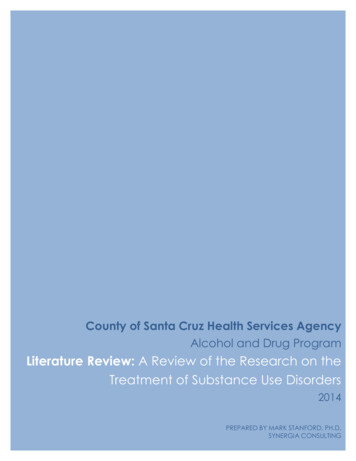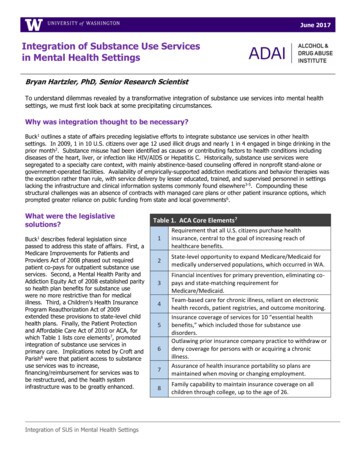
Transcription
June 2017Integration of Substance Use Servicesin Mental Health SettingsBryan Hartzler, PhD, Senior Research ScientistTo understand dilemmas revealed by a transformative integration of substance use services into mental healthsettings, we must first look back at some precipitating circumstances.ConsideringLockedvs. UnlockedthoughtTreatment FacilitiesWhy wasintegrationto be necessary?Buck1 outlines a state of affairs preceding legislative efforts to integrate substance use services in other healthsettings. In 2009, 1 in 10 U.S. citizens over age 12 used illicit drugs and nearly 1 in 4 engaged in binge drinking in theprior month2. Substance misuse had been identified as causes or contributing factors to health conditions includingdiseases of the heart, liver, or infection like HIV/AIDS or Hepatitis C. Historically, substance use services weresegregated to a specialty care context, with mainly abstinence-based counseling offered in nonprofit stand-alone orgovernment-operated facilities. Availability of empirically-supported addiction medications and behavior therapies wasthe exception rather than rule, with service delivery by lesser educated, trained, and supervised personnel in settingslacking the infrastructure and clinical information systems commonly found elsewhere3-5. Compounding thesestructural challenges was an absence of contracts with managed care plans or other patient insurance options, whichprompted greater reliance on public funding from state and local governments6.What were the legislativesolutions?1Buck describes federal legislation sincepassed to address this state of affairs. First, aMedicare Improvements for Patients andProviders Act of 2008 phased out requiredpatient co-pays for outpatient substance useservices. Second, a Mental Health Parity andAddiction Equity Act of 2008 established parityso health plan benefits for substance usewere no more restrictive than for medicalillness. Third, a Children’s Health InsuranceProgram Reauthorization Act of 2009extended these provisions to state-level childhealth plans. Finally, the Patient Protectionand Affordable Care Act of 2010 or ACA, forwhich Table 1 lists core elements7, promotedintegration of substance use services inprimary care. Implications noted by Croft andParish8 were that patient access to substanceuse services was to increase,financing/reimbursement for services was tobe restructured, and the health systeminfrastructure was to be greatly enhanced.Integration of SUS in Mental Health SettingsTable 1. ACA Core Elements71Requirement that all U.S. citizens purchase healthinsurance, central to the goal of increasing reach ofhealthcare benefits.2State-level opportunity to expand Medicare/Medicaid formedically underserved populations, which occurred in WA.345678Financial incentives for primary prevention, eliminating copays and state-matching requirement forMedicare/Medicaid.Team-based care for chronic illness, reliant on electronichealth records, patient registries, and outcome monitoring.Insurance coverage of services for 10 “essential healthbenefits,” which included those for substance usedisorders.Outlawing prior insurance company practice to withdraw ordeny coverage for persons with or acquiring a chronicillness.Assurance of health insurance portability so plans aremaintained when moving or changing employment.Family capability to maintain insurance coverage on allchildren through college, up to the age of 26.
What impacts did this have for provision of substance use services?McLellan and Woodworth7 note several relevant consequences of the ACA:Of 25 million adults meeting criteria for a substance use disorder, expanded Medicaid benefits was estimated toextend coverage to 12% more of this population, and to a much higher proportion of those who engage insubthreshold yet still medically harmful substance use.Specialty care settings faced new market forces, with some effectively adapting to assimilate moderninformation/billing systems, adopt evidence-based therapeutic practices, and embrace a chronic care perspective.Many of those failing to adapt have since closed their doors.An influx of persons newly-eligible for services exceeded capacity of the specialty care system, prompting efforts toimplement screening and brief intervention procedures in primary care. These efforts, not without logistical andphilosophical challenges, are continuing.Owing to increased recognition of substance use disorders as chronic illnesses, evidence-based strategies for diseasemanagement and outcomes monitoring were extended to substance use services. This, too, is an evolving effort forhealth systems and their personnel.Mainstreaming of substance use services sought to reduce stigmatization and marginalization. These processes willneed to persist to counteract future legislative efforts that may seek to undermine progress in how those seekingsubstance use services are treated.Has integrating substance use services in mental health settings improved patientoutcomes?Systematic reviews suggest that those who receive integrated mental health and substance use services do showclinical improvement9,10 and report treatment satisfaction11. Some note a greater degree of clinical utility in theintegration of mental health services than for substance use services, with the strongest empirical support among thelatter suggested for screening and brief intervention for alcohol misuse and tobacco cessation interventions 12,13. Asnoted by Croft and Parrish8, the integrated care initiatives undertaken since passage of the ACA have not forgedevidence of robust clinical effectiveness that might otherwise prompt larger systemic shifts toward comprehensive careintegration. Thus, many questions of the relative utility of integrated care services among special patient populationsremain unanswered.A review by Priester and colleagues14 further highlights issues of health disparity. One salient dimension is residentialgeography, as those living in rural or under-resourced areas have lesser access to integrated care programs 15. Thatdisparity is compounded by findings that geographic proximity and absence of transportation to reach services remainpervasive barriers to care16,17. A 2nd dimension is culture, as absence of cultural competence in a given care settingcontributes to under-representation of ethnic/racial and sexual minority groups among those accessing its availablemental health and substance use services18. Though clinical services often are tailored to patients’ gender and stageof-life, there is a dearth of comparative study examining these as moderating influences of the utility of integratedmental health and substance use services.In what settings can integrated mental health and substance use services occur?Given an estimated 7.9 million adults in the U.S. with co-occurring mental health and substance use disorders 20 andongoing health system transformation, persons in need of integrated care may present for services at an everincreasing range of health providers. In addition to primary care settings 1,7, these are likely to include: communityhealth centers, inpatient service providers, hospitals, specialty care centers, independent practitioners in privatepractice, jails and prisons, mutual/peer support organizations, schools, and telehealth or home-based serviceproviders.Integration of SUS in Mental Health Settings2 Page
Integrated care—principally involvingindividual and group counseling, medicationassisted treatments, and support services—hold potential to offer tangible clinical benefitin the form reductions in substance use,psychiatric symptomatology, acute care needs,and criminal justice involvement as well asincreases in overall functioning, housingstability, and quality-of-life. Figure 1illustrates an adapted classification scheme forpersons with co-occurring disorders19, as wellas indication of health settings whereparticular patient groups may be most likely topresent for integrated care services. Whileintended as a heuristic, this may offer ahelpful guide as settings move towardredesign in order to provide integrated care.Irrespective of the specific health setting inquestion, a common set of guiding principlesfor integrated care21 are outlined in Table 2.Figure 1. Adapted classification scheme for co-occuring disorders19.The principles are intended as a guide toprovision of integrated care for patientsvarying in age, gender, race/ethnicity, or socioeconomic circumstance. Integrated care is thought to provideconsistent, useful messaging to all patients about treatment and recovery.Table 2. Principles of Integrated Care for Co-Occurring Disorders211Mental health and substance abuse treatment are integrated to meet the needs of people with co-occurring disorders.2Integrated treatment specialists are trained to treat both substance use disorders and serious mental illnesses.3Co-occurring disorders are treated in a stage-wise fashion with different services provided at different stages.4Motivational interventions are used to treat consumers in all stages, but especially at initial points.5Substance abuse counseling, using a cognitive-behavioral approach, is used both prospectively and in relapse prevention.6Multiple formats for services are available, including individual, group, self-help, and family.7Medication monitoring is coordinated with behavioral services.What structural barriers exist for integrated mental health and substance useservices?The historical separation of mental health and substance use services contributes to an overall health system that isdifficult for persons with co-occurring disorders to navigate. Priester and colleagues14 also note structuralcharacteristics of treatment programs and systems that pose barriers to integrating mental health and substance useservices. One is service access, with the comprehensive screening and assessment procedures that integrated carerequires still absent in many community mental health settings 22. Relatedly, insufficient workforce training to identifyboth mental health and substance use disorders poses a further barrier to service integration 23,24. While training ofmental health staff is suggested to provide better preparation to identify dual diagnoses25, interdisciplinary training isproposed as means to increase system capacity to implement comprehensive diagnostic procedures26. Other barriersrelate to service availability and timing—with use of entry requirements (like substance abstinence) and lengthyIntegration of SUS in Mental Health Settings3 Page
waitlists, bureaucratic ‘red tape’ during enrollment, inflexible hours during which services are offered, and providerantipathy and selection bias all noted as limiting utilization27-29.In addition to structural barriers, interdisciplinary differences in understanding and philosophy about addiction as anillness constitute a significant systemic barrier to the integration of mental health and substance use services. Volkowand McLellan30 note common myths and misconceptions about opiate addiction that persist as barriers to adoption ofsubstance use services by health professionals. Table 3 provides a selected list of myths and misconceptions.What is recommended for overcoming these structural and philosophical barriers?Practical suggestions for overcoming structural barriers among dually-diagnosed patients are co-location andintegration of assessment, case management, and treatment services, as well as simplification of care systems to asingle-entry point29,31. Other suggestions, particularly in rural areas, are for opportunistic use of technology topromote service access and wrap-around services whereby varied needs may be met32. As for philosophical barriers,suggestions include increased dual disorder identification via universal screening and diagnostic assessment 25,26,effective treatment referral via frequent interdisciplinary communication and collaboration 22, and mitigation of healthdisparities by targeting of cultural competence as a workforce aim 18.MythFactAddiction is the sameas physicaldependence andtolerance.This misconception leads some clinicians to avoid prescribing addiction medicationswho would benefit from them and many patients to be afraid of taking suchmedications as prescribed.Addiction is simply aset of bad choices.This misconception contributes to the discrimination against patients with addictionand to the willful ignorance by many in the health care system about moderntreatment methods. It also promotes mistrust of patients by clinicians and preventsaffected patients from seeking help for their addiction.Only patients withcertain characteristicsare vulnerable toaddiction.Certain conditions do increase the vulnerability to addiction, including substance usedisorder, adolescent developmental stage, and some mental health comorbidities(i.e., attention deficit–hyperactivity disorder, major depressive disorder). Althoughsome patients are more vulnerable than others, no patient is immune to addiction.Medication-assistedtreatments are justsubstitutes for streetdrugs.Use of opioid-agonist medications such as methadone and buprenorphine for opioidaddiction has led to the misconception that such drugs are just substitutes for theopioid being abused. Although these medications are opioid agonists, their slowerbrain pharmacokinetics along with more stable concentrations stabilize physiologicprocesses otherwise disrupted by intermittent abuse of opioids. Use of thesemedications also protects against risks associated with opioid abuse duringrecovery.Table 3. Common myths and misconceptions about addiction, adapted from Volkow and McLellan30.Croft and Parrish8 also strongly advocate that stakeholders from both mental health and addiction settings activelyengage in health care reform activities, such that they attain and maintain a voice in persisting debates about healthsystem integration. This will continually position them to effectively advocate for the needs of the dually-diagnosedpopulations they serve, as issues of care integration begin to intersect more directly with health-involved challengeslike affordable housing and employment. It is hoped that, ultimately, settings that overcome existing barriers andeffectively integrate mental health and substance use services may then avoid traditional fragmentation and insteadprovide care for the ‘whole person.’Integration of SUS in Mental Health Settings4 Page
What might integrative models for substance use services look like in mental healthsettings?A 2009 review by Armitage and colleagues 34 notes 175 different definitions of care integration, suggesting efforts tointegrate substance use services into mental health settings are likely to be uniquely influenced by setting aims,structure, and resources. Nevertheless, classification of such efforts holds heuristic value. Blount33 distinguishes threetypes of care integration, with contemporary examples of application of relevant substance use services for duallydiagnosed patients in mental health settings—screening, diagnosis, case management, behavioral and medicationassisted treatment, and referral for complementary services—outlined in Table 4.Table 4. Models of Care Integration for Substance Use Disorders in Mental Health 33CoordinatedcareAddiction care and mental health professionals practice separately and often in distinctlocations, albeit with an integrated patient records system and common underlying fundingsources. Both sets of staff groups diagnose, provide case management and behavior therapies,and oversee medication-assisted treatments in their own areas of expertise, with basic screeningand referral as needed for complementary services for substance use and mental health disorders.Co-locatedcareAddiction care and mental health professionals practice together, with delineation of servicesaccording to expertise. Both sets of staff diagnose, provide case management and behaviortherapies, and oversee medication-assisted treatments in their own areas of expertise, with basicscreening and referral as needed for complementary services for substance use and mental healthdisorders. Co-location facilitates formal and informal communication that augments cross-linkagefor service referrals.IntegratedcareAddiction care and mental health professionals collaboratively design and implement unifiedcare plans, with close and continuing cohesion. Both sets of staff are core members of integratedcare teams that perform screening, conduct behavioral assessment and diagnosis, provide casemanagement and behavior therapies, and oversee medication-assisted treatments. Integratedcare offers benefits in more informed and immediate responses to emergent issues posed byclinical comorbidity.Can integrated mental health and substance use services also be trauma-informed?Increasingly, experience of physical and emotional trauma is recognized as prevalent as well as influential onaccessing of, participation in, and response to care. This is of elevated concern for women, children, military veterans,persons with disabilities, the elderly, and ethnic/racial and sexual minorities. Trauma-informed care encompasses howtreatment systems both understand and respond to persons who have experienced or are at-risk for traumatic events.Table 5 defines four key elements of trauma-informed care35,Table 5. Key Elements of Trauma-Informedforwhich setting implementation is a transformative processCare35implicating policies and procedures to decrease patients’current reactions to prior traumatic events as well as preventRecognition of the pervasive intra- and1future experience of additional traumatic events.interpersonal influences of traumaIntegrating mental health and substance use services is a loftyundertaking, given the structural and philosophical barriers formany treatment settings and systems detailed earlier in thisreport. Ensuring that integrated care is also trauma-informedClinical responses that apply such understanding of3clearly adds weight to this task. While extant literature doestrauma-related impactsnot directly address the comparative utility or effectiveness ofintegrated care that is vs. is not trauma-informed, integrationClinical responses that seek to prevent future4of trauma-informed perspectives in design and implementationre-experiencing of traumatic eventsof health services has been strongly recommended amongadvocates of many patient groups 36-38. If a treatment setting or system seeks to accomplish this amidst integrating itsmental health and substance use services, targeted effort will be needed to minimize potentially traumatic ordistressing aspects of care processes. Moreover, the setting or system will need to provide reassurance, hope, andeffectively coping supports when patients—and their caregivers and/or family members—do encounter such distress.2Understanding of how traumatic experience directlyand vicariously impacts patients and staffIntegration of SUS in Mental Health Settings5 Page
What is recommended for health settings to increase capacity to integrate care?Padwa and colleagues39 highlight integrated behavioral care capacity as a measurable construct comprised of ‘inner’and ‘outer’ context factors. Outer context includes a sociopolitical context (i.e., legislative policy), funding (i.e.,continuity), patient advocacy (i.e., partnered consumer agencies), and networking (i.e., linkage to otherfacilities/professional groups). Inner context includes setting attributes (i.e., size, absorptive capacity), personnel (e.g.values, openness to change), style of leadership (i.e., active), mission (i.e., ideology), and resources (i.e., capacity forstaff oversight). Chaple and colleagues 40,41 outline recommendations for increasing integrative behavioral carecapacity, based on an empirically-supported technical assistance approach utilized to enhance capacity of a set offederally qualified health centers to support integration of behavioral health services. These proceduralrecommendations are listed in Table 6.Table 6. Recommendation for Increasing Integrative Behavioral Care Capacity 40,411Obtain top-down support so setting leadership demonstrates buy-in to positive influence settingculture to embrace and institutionalize substance use services in routine practice.2Elicit input from and involve key clinical staff in sculpting new services to enhance the investment andcommitment of those staff for those services.3Facilitate a change process, with program leadership and clinical staff comprising implementationteams or informal partnerships that guide implementation of new services.4Promote peer-to-peer learning about implementing new services so inter-agency collaboration enablessharing and learning among staff from multiple treatment organizations.5Employ measurement and feedback processes to enable real-time feedback at iterative points thatfosters rapid cycle improvement in the implementation of new services.6Build staff readiness and competencies via training and tools for clinical staff including initialworkshops and subsequent technical assistance processes to assist navigation of barriers.Additional Resources APA-APM Report: Dissemination of Integrated Care within Adult Primary Care Settings. tergood Foundation Series on Behavioral Health Policy. aper-seriesWashington State. DSHS/DBHR. “Why SBIRT.” alth-and-recovery/why-sbirtBree Collaborative. Behavioral Health Integration Report and Recommendations. ns-2017-03.pdfWashington State. SBIRT Primary Care Integration. hington State. Research and Data Analysis. RDA Report .pdfSAMHSA-HRSA Center for Integrated Health Solutions (CIHS). 4.5.Buck JA. The looming expansion and transformation of public substance abuse treatment under the Affordabel Care Act. Health Affairs.2011;30:1402-1410.SAMHSA. Results from the 2009 National Survey on Drug Use and Health. Rockville, MD: SAMHSA;2010.McLellan AT, Carise D, Kleber HD. Can the national addiction treatment infrastructure support the public's demand for quality care?Journal of Substance Abuse Treatment. 2003;25(2):117-121.McLellan AT, Meyers K. Contemporary addiction treatment: A review of systems problems for adults and adolescents. BiologicalPsychiatry. 2004;56(10):764-770.Roman PM, Ducharme LJ, Knudsen HK. Patterns of organization and management in private and public substance abuse treatmentprograms. Journal of Substance Abuse Treatment. 2006;31(3):235-243.Integration of SUS in Mental Health Settings6 Page
.41.Levit KR, Kassed CA, Coffey RM, et al. Projections of national expenditures for mental helath services and substance abuse treatment,2004-2014. Rockville, MD2008.McLellan AT, Woodworth AM. The affordable care act and treatment for 'substance use disorders': Implications of ending segregatedbehavioral healthcare. Journal of Substance Abuse Treatment. 2014;46:541-545.Croft B, Parish SL. Care integration in the Patient Protection and Affordable Care Act: Implications for behavioral health. Administrationand Policy in Mental Health and Mental Health Services. 2013;40(4):258-263.Drake RE, O'Neal, E.L., Wallach MA. A systematic review of psychosocial research on psychosocial interventions for people with cooccuring severe mental and substance use disorders. Journal of Substance Abuse Treatment. 2008;34:123-128.Donald M, Dower J, Kavanagh D. Integrated versus non-integrated management and care for clients with co-occurring mental health andsubstance use disorders: A qualitative systematic review of randomised controlled trials. Social Science & Medicine. 2005;60:1371-1383.Schulte SJ, Meier PS, Stirling J. Dual diagnosis clients' treatment satisfaction - a systematic review. BMC Psychiatry. 2011;11:1.Agency for Healthcare Research and Quality. Integration of mental health/substance abuse and primary care. Rockville, MD: Agency forHealthcare Research and Quality;2008.Archer J, Bower P, Gilbody S, et al. Collaborative care for depression and anxiety problems. Cochrane Database Systematic Review.2012;10:CD006525.Priester MA, Browne T, Iachini A, Clone S, DeHart D, Seay KD. Treatment access barriers and disparities among individuals with cooccurring mental health and substance use disorders: An integrative literature review. Journal of Substance Abuse Treatment.2016;61:47-59.Hester RD. Integrating behavioral health services in rural primary care settings. Substance Abuse. 2004;25:63-64.Adler G, Pritchett LR, Kauth MR, Mott J. Staff perceptions of homeless veterans' needs and available services at community-basedoutpatients clinics. Journal of Rural Mental Health. 2015;39(1):46-53.Godley SH, Finch M, Dougan L, McDonnel M, McDermeit M, Carey A. Case management for dually diagnosed individuals involved in thecriminal justic system. Journal of Substance Abuse Treatment. 2000;18:137-148.Eliason M, Amodia D. A descriptive analysis of treatment outcomes for clients with co-occurring disorders: The role of minorityidentifications. Journal of Dual Diagnosis. 2006;2:89.SAMHSA. Substance abuse treatment for persons with co-occurring disorders. Rockville, MD2005.Center for Behavioral Health Statistics and Quality. Behavioral health trends in the United States: Results from the 2014 National Surveyon Drug Use and Health. Rockville, MD2015.SAMHSA. Integrated treatment for co-occurring disorders: Building your program. Rockville, MD: U.S. Department of Health and HumanServices;2009.Sterling S, Weisner C, Hinman A, Parthasarathy S. Access to treatment for adolescents with substanc use and co-occurring disorders:Challenges and opportunities. Journal of the American Academy of Child and Adolescent Psychiatry. 2010;49:637-646.Foster S, LeFauve C, Kresky-Wolff M, Rickards L. Services and supports for individuals with co-occurring disorders and long-termhomelessness. The Journal of Behavioral Health Services and Research. 2010;37:239-251.Green AE, Drake RE, Brunette MF, Noordsy D. Schizophrenia and co-occurring substance use disorder. American Journal of Psychiatry.2007;164:402-408.Kerwin ME, Walker-Smith K, Kirby KC. Comparative analysis of state requirements for the training of substance abuse and mental healthcounselors. Journal of Substance Abuse Treatment. 2006;30:173-181.Hawkins EH. A tale of two systems: Co-occurring mental health and substance abuse disorders treatment for adolescents. Annual Reviewof Psychology. 2009;60:197-227.Grella CE, Gil-Rivas V, Cooper L. Perceptions of mental health and substance abuse program administrators and staff on service deliveryto persons with co-occurring substance abuse and mental disorders. The Journal of Behavioral Health Services and Research. 2004;31:3849.Libby AM, Riggs PD. Integrated substance use and mental health treatment for adolescents: Aligning organizational and financialincentives. Journal of Child & Adolescent Psychopharmacology. 2005;15:826-834.Drake RE, Morse GG, Brunette MF, Torrey WC. Evolving U.S. service model for patients with sever mental illnesses and co-occurringsubstanc use disorder. Acta Neuropsychiatrica. 2004;16:36-40.Volkow ND, McLellan AT. Opioid abuse in chronic pain - misconceptions and mitigation strategies. The New England Journal of Medicine.2016;374(13):1253-1263.Minkoff K. Best practices: Developing standards of care for individuals with co-occurring psychiatric and substance use disorders.Psychiatric Services. 2014;52:597-599.Browne T, Priester MA, Clone S, Iachini A, DeHart D, Hock R. Barriers and facilitators to substance use treatment in the rural south: Aqualitative study. The Journal of Rural Health. 2016;32(1):92-101.Blount A. Integrated primary care: Organizing the evidence. Families, Systems, & Health. 2003;21:121-133.Armitage GD, Suter E, Oelke ND, Adair CE. Health systems integration: State of the evidence. International Journal of Integrated Care.2009;9:2.SAMHSA. Trauma-informed care in behavioral health services. Rockville, MD: SAMHSA;2014.Sales JM, Swartzendruber A, Phillips AL. Trauma-informed HIV prevention and treatment. Current HIV/AIDS Reports. 2016;13(6):374-382.Marsac ML, Kassam-Adams N, Hildenbrand AK, et al. Implementing a trauma-infromed approach in pediatric health care networks. JAMAPediatrics. 2016;170(1):70-77.Decker MR, Flessa S, Pillai RV, et al. Implementing trauma-informed partner violence assessment in family planning clinics. Journal ofWomen's Health. 2017;in press.Padwa H, Teruya C, Tran E, et al. The implementation of integrated behavioral health protocols in primary care settings in Project Care.Journal of Substance Abuse Treatment. 2016;62:74-83.Chaple M, Sacks S, Randell J, Kang B. A technical assistance framework to facilitate the delivery of integrated behavioral health services infederally qualified health centers (FQHCs). Journal of Substance Abuse Treatment. 2016;60:62-69.Chaple M, Sacks S. The impact of techical assistance and implementation support on program capacity to deliver integrated services.Journal of Behavioral Health Services & Research. 2016;43(1):3-17.Integration of SUS in Mental Health Settings7 Page
Citation: Hartzler B. Integration of Substance Use Services in Mental Health Settings. Alcohol & Drug Abuse Institute,University of Washington, June 2017. URL: fThis report was produced with support from the Washington
mental health and substance use services. In what settings can integrated mental health and substance use services occur? Given an estimated 7.9 million adults in the U.S. with co-occurring mental health and substance use disorders20 and ongoing health system transformation, persons in need of integrated care may present for services at an ever-

